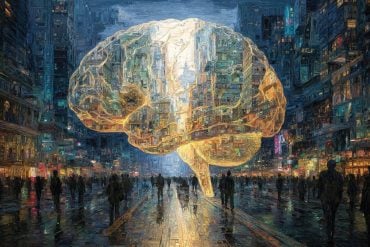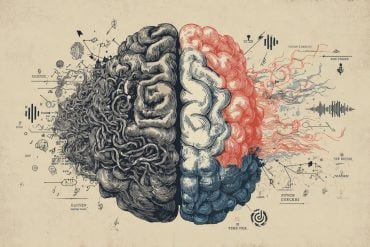Summary: In times of uncertainty, noradrenaline helps us learn and adapt our behaviors, researchers report.
Source: University of Cambridge
A brain chemical called noradrenaline is responsible for our responses to uncertain situations — helping us to learn quickly and adapt our behavior, a new study has found.
The COVID-19 pandemic has plunged us all into a state of uncertainty. In a rapidly changing situation where it is hard to know what will happen next, making decisions can be difficult. Researchers at the University of Cambridge and University College London created a simplistic model of this uncertain situation in the lab, to understand how our brain responds.
They found that when situations seem stable, we tend to rely on our on previous experiences to help us anticipate what will happen in the future. But when the world is volatile, our brain can let go of these expectations and allow rapid learning. The balance between the two approaches is moderated by the brain chemical noradrenaline. The study is published today in the journal Current Biology.
“Adapting to uncertain situations helps us to survive. When something unexpected happens, we have to decide whether it’s a one-off and ignore it, or whether it’s going to keep happening — in which case we might benefit by doing things differently,” said Dr Rebecca Lawson, a researcher in the University of Cambridge’s Department of Psychology and lead author of the study.
The study tested the effects of Propranolol — a drug used to reduce anxiety and blood pressure — on how people responded to stable situations and to changeable ones. Propranolol blocks the action of noradrenaline.
Participants in the experiment — who were not suffering with anxiety — heard a sound and were then shown an image of either a house of a face. They quickly learned to predict the image they would see depending on the sound they heard before it appeared. The association between particular sounds and images was then changed at random intervals, increasing uncertainty and requiring participants to quickly learn new associations.
The reaction times of participants who received a placebo drug slowed down as the associations became more unexpected. Those who received Propranolol relied on the sound to a greater extent when uncertainty was high. This suggests that the drug makes people more likely to rely on their expectations, based on prior experience, in the face of uncertainty — which could be how it works to reduce feelings of anxiety.
Using a computational model, the researchers showed that the Propranolol group were slower than the placebo group at learning to use new information to adjust their expectations of what might come next, when a situation is very uncertain.
“We found that a brain chemical called noradrenaline plays a role in our inability to predict the future when the state of the world is volatile,” said Lawson.
When a situation is stable — represented in the experiment by a fixed link between sounds and images — our past experiences can be relied upon as a good guide to what will happen next. But when a situation is changing, we need to be more receptive to new information to try and work out what is happening and how to respond.

“In the face of uncertainty, people taking the anti-anxiety drug Propranolol showed an increased reliance on past experience to inform their behaviour — they were less influenced by changes in their environment that contradicted that experience,” said Lawson.
Difficulty in balancing expectations against new information is thought to underlie many conditions including autism and anxiety. The team plans to extend their research to try and understand how people with these conditions learn under uncertainty. In the longer term, this could help those with autism and anxiety to recognize the source of their anxiety and manage it better.
About this neuroscience and learning research news
Source: University of Cambridge
Contact: Press Office – University of Cambridge
Image: The image is in the public domain
Original Research: Open access.
“The Computational, Pharmacological, and Physiological Determinants of Sensory Learning under Uncertainty” by Rebecca P. Lawson, James Bisby, Camilla L. Nord, Neil Burgess, Geraint Rees. Current Biology
Abstract
The Computational, Pharmacological, and Physiological Determinants of Sensory Learning under Uncertainty
Highlights
- •Propranolol increases the effects of expectations on behavior
- •Propranolol reduces volatility-linked learning
- •Propranolol reduces the impact of prediction errors and volatility on pupil size
- •Systolic blood pressure predicts estimated environmental volatility
Summary
The ability to represent and respond to uncertainty is fundamental to human cognition and decision-making. Noradrenaline (NA) is hypothesized to play a key role in coordinating the sensory, learning, and physiological states necessary to adapt to a changing world, but direct evidence for this is lacking in humans. Here, we tested the effects of attenuating noradrenergic neurotransmission on learning under uncertainty. We probed the effects of the β-adrenergic receptor antagonist propranolol (40 mg) using a between-subjects, double-blind, placebo-controlled design. Participants performed a probabilistic associative learning task, and we employed a hierarchical learning model to formally quantify prediction errors about cue-outcome contingencies and changes in these associations over time (volatility). Both unexpectedness and noise slowed down reaction times, but propranolol augmented the interaction between these main effects such that behavior was influenced more by prior expectations when uncertainty was high. Computationally, this was driven by a reduction in learning rates, with people slower to update their beliefs in the face of new information. Attenuating the global effects of NA also eliminated the phasic effects of prediction error and volatility on pupil size, consistent with slower belief updating. Finally, estimates of environmental volatility were predicted by baseline cardiac measures in all participants. Our results demonstrate that NA underpins behavioral and computational responses to uncertainty. These findings have important implications for understanding the impact of uncertainty on human biology and cognition.






